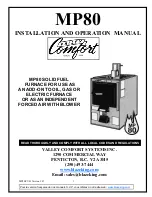
107273-UUM-C-0306
Unitary Products Group
17
INSTRUCTIONS FOR EXAMINING THE FURNACE
It is the owner’s responsibility to ensure that an annual inspection of the
entire heating portion of the unit is made by a qualified service
agency. Examine the furnace as outlined below in steps “1 - 6” before
each heating season. Use Figures 15 and 16 for visual reference.
1.
Examine the heat exchanger, through a field installed access
panel located on the supply air plenum. Visually examine the exte-
rior sections of the vent/combustion air piping and the connectors
to be sure that they are physically sound without holes or exces-
sive corrosion.
2.
Examine the outside vent/combustion air pipe making sure it is
firmly in place, is physically sound without holes, and all of the
connections are secure.
3.
Examine the return air filter rack connections on the blower door to
make sure they are physically sound, and secured to the furnace
casing.
4.
Examine the furnace casing making sure the physical support is
sound without sagging, cracks or gaps. Examine the furnace base
making sure it is physically sound without cracks, gaps or sagging
and has a good seal.
5.
Examine the furnace casing for obvious signs of deterioration.
6.
Examine the burner flames to make sure the burners look like they
are operating properly. The burner flames for natural gas should
appear blue without smoking at the tips. LP is blue with yellow tips
and no smoking. The flame should appear cylindrical in shape and
should extend from the end of the burner into the heat exchanger
chamber. Refer to the pictorial sketch shown in Figure 16 as a
comparison to the actual flame.
If, during the inspection of your furnace, you find any of the following
conditions:
•
Excessive amounts of dust and lint on components.
•
Damaged or deteriorated components or surfaces.
•
Leaks or blockage in the vent pipe passages.
•
Water on any surface inside or outside of the furnace.
Do not operate the furnace, call a certified dealer / servicing contractor
to check and / or clean your furnace, or for more information if you have
questions about the operation of your furnace.
If all components appear to be in good operating condition, replace the
front panels. Follow the operating instructions to place the furnace in
operation.
Observing Burner Operation
1.
Observe burner to make sure it ignites. Observe color of flame. On
natural gas the flame will burn blue with appreciably yellow tips.
On Propane gas a yellow flame may be expected. If flame is not
the proper color call a qualified service technician for service.
2.
Let furnace heat until blower cycles on.
3.
Turn thermostat down.
4.
Observe burner to make sure it shuts off.
5.
Let the furnace cool and blower cycle off.
If any abnormalities are observed when checking for correct operation,
such as burner failing to ignite or to turn off, sooty flame, etc., call your
nearest authorized service technician as shown in the Service Center
List included in the home owner envelope with the furnace.
SEASONAL SERVICE INFORMATION
During extreme cold weather, ice may form on the furnace roof jack
crown. Small amounts of ice forming on the roof jack will present no
problem to proper furnace operation. However, excessive ice formation
could restrict the combustion air supply to the burner causing inefficient
burner operation.
When the temperature is very cold, near zero or below, it is recom-
mended that the roof jack be inspected every day or more frequently if
required. If ice has started to collect on the roof jack crown, it should be
carefully broken off.
FIGURE 15: Component Locations
FIGURE 16: Burner Flame Drawing
Roof Jack
Vent Connection
Blower Motor
Capacitor
Blower Motor
Auxiliary Limit
Control Box
Line Voltage
Connections
Blower Housing
& Wheel
4” Combustion
Air pipe
Fan Switch
Limit Switch
Supply Voltage Wires to
Primary Control Junction Box
2” Flexable
PVC Pipe
Combustion Air
Adjustment Damper
24” V Wires to “T” and “T”
Terminals on Primary Control
Low Voltage
Connections
Gas Valve
Burner Primary
Control
Burner
Motor
Primary
Control
Junction Box
Gas Orifice Spud
DFAA A/C Coil Cabinet
NATURAL GAS
PROPANE GAS
Light Blue
With Yellow Tips
Dark Blue
Blue Tips Just
Starting to
Become Pronounced
Whitish Yellow
to Light Yellow
Light Blue
Blue Tips Just
Starting to
Become Pronounced
FIGURE 17: Furnace Examination Checkpoints
1. Examine Vent Pipe
2. Examine Filter Door
3. Remove Filter
Door to Examine
Combustion Air Pipe
4. Examine Burner Door
5. Remove Burner
Door to Examine
Furnace Base and
Air Conditioning
Coil Panels
7. Remove Burner
Door to Examine
Burner Flame
Содержание DFAA
Страница 15: ...107273 UUM C 0306 Unitary Products Group 15 FIGURE 14 Wiring Diagram for DFAH Oil Fired Furnace ...
Страница 22: ...107273 UUM C 0306 22 Unitary Products Group FIGURE 21 Wiring Diagram for DFAH Gas Conversion Burner ...
Страница 31: ...107273 UUM C 0306 Unitary Products Group 31 NOTES ...








































